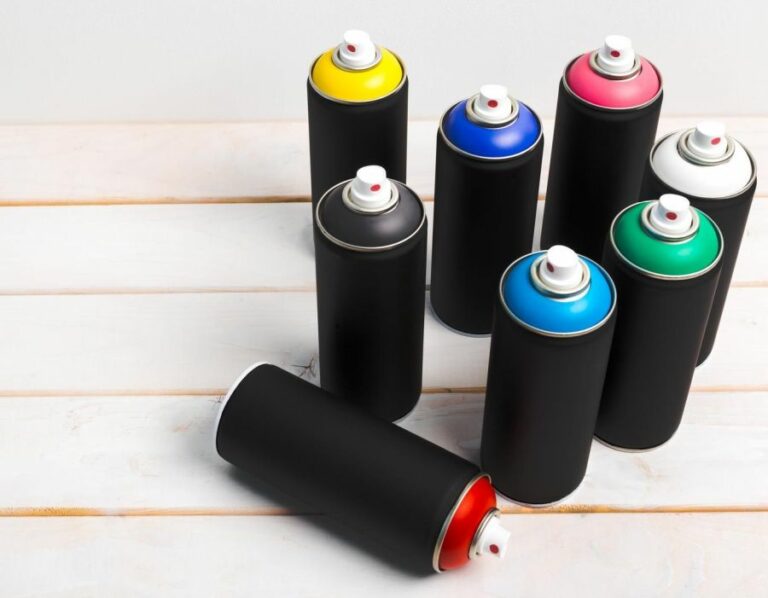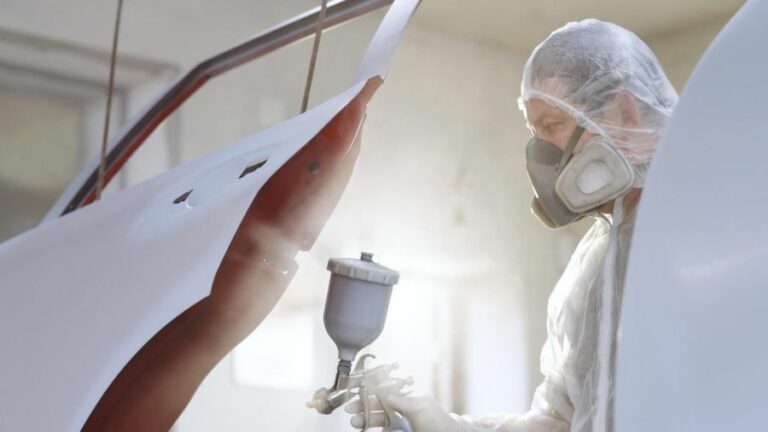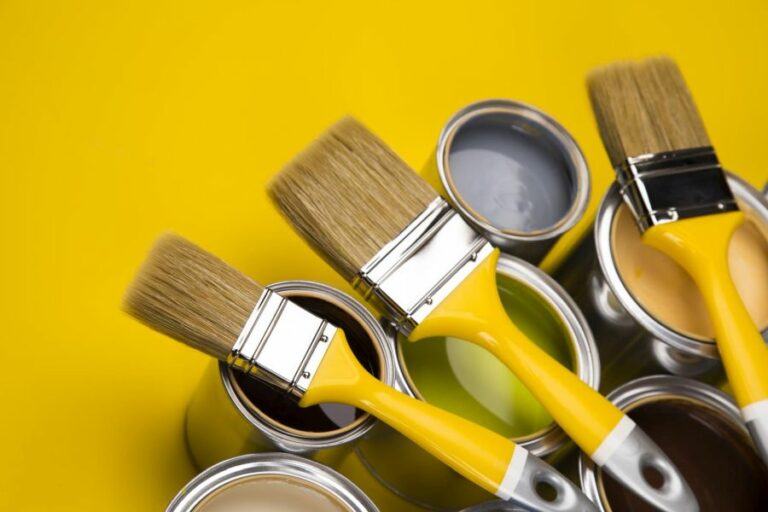Can You Paint Over Outdoor Paint, 25 Things You Should Know
Are you considering a fresh look for your outdoor space but unsure if painting over existing outdoor paint is feasible? Our latest blog post, ‘Can You Paint Over Outdoor Paint,’ is here to dispel your doubts and provide expert guidance.
Can you paint over outdoor paint:
Repainting over exterior paint is feasible and enhances the aesthetics of surfaces. Before starting, consider factors such as surface condition, paint compatibility, and environmental factors. Ensure the surface is clean, smooth, and free of imperfections. Use compatible paints and consider climate elements like temperature, humidity, and precipitation. Follow a systematic process, including cleaning, addressing discrepancies, priming, and applying paint layers. With attention to detail and patience, repainting outdoor surfaces can be successful.

Before attempting to paint over outdoor paint, it’s essential to consider factors like surface type, existing paint condition, and appropriate products. Discover expert tips and practical guidance for a seamless, long-lasting finish in this comprehensive guide. Dive in to learn more!
Contents
- 1 Is it Possible to Apply a Fresh Coat Over Exterior Paint?
- 2 Is It Necessary to Remove All Exterior Paint Before Repainting?
- 3 Is It Possible to Apply a New Coat of Paint Over Existing Paint?
- 4 Is It Necessary to Apply Primer Over Existing Exterior Paint?
- 5 Is it Possible to Apply Interior Paint Over Exterior Paint?
Is it Possible to Apply a Fresh Coat Over Exterior Paint?
• Exploring the Nuances of Outdoor Paint Overhauls
Yes, indeed! Repainting over outdoor paint is not only feasible but also invigorates the aesthetic appeal of exterior surfaces.
– The Multiplicity of Factors: A Holistic Approach
Before brandishing the paintbrush, one must first consider a multitude of elements to enhance the adhesion and subsequent longevity of the new paint coat. These encompass the surface’s condition, paint compatibility, and environmental considerations.
Delving into Surface Examination
The foundation of a sumptuous repainting venture is a thorough evaluation of the existing surface. Addressing imperfections such as peeling or blistering augments the impeccability of the final result. Abide by these vital steps to guarantee an exemplary substrate:
- Scrape away loose, flaking, or peeling paint from the surface with alacrity
- Sand the substrate assiduously to achieve a smooth-textured canvas for paint application
- Eradicate traces of mildew with an efficacious solution, ensuring a pristine surface
- Revitalize porous surfaces with an appropriate primer and indelibly seal fissures and hairline cracks
Paint Compatibility: Meticulous Matchmaking
Selecting an optimal paint match is a pivotal factor in the success of your repainting escapades. A felicitous paint combination offers maximum adhesion and prevents cross-reactions and disintegration through a harmonious union.
Enigmatic Alchemy: Latex and Oil-Based Paints
- Latex over Latex: A propitious pairing, this affords impeccable adhesion and a stellar finish.
- Latex over Oil: Indubitably viable, provided a compatible primer creates a durable bond.
- Oil over Latex: Exercise caution, as this may result in egregious peeling or chaotic cracking.
Embracing Environmental Responsiveness
Captivating climate considerations are indispensable to your quest of repainting over outdoor paint. Albeit often overlooked, this facet profoundly influences the paint’s drying, curing, and tenacity. Heed these considerations:
- Temperature: Endeavor to paint when the mercury hovers between 50°F (10°C) and 90°F (32°C).
- Humidity: Refrain from painting amidst finicky fluctuations in humidity.
- Precipitation: Eschew painting on inclement days, allowing ample time for the surface to dry post-rain.
– A Chronology of Steps: The Procedure Unraveled
An efficacious paint job demands methodical artistry. To repaint over existing outdoor paint, adhere to the following approach:
- The Surface Purge: Embark on a rigorous cleaning regimen, removing any vestiges of dirt, grime, or mold with alacrity.
- A Scrutiny of Sundry Surfaces: Scrutinize the substrate for blemishes and address any discrepancies that may disrupt the uniformity of the new paint.
- Priming for Perfection: Behold! A judicious application of primer fortifies the surface, thereby bolstering the adhesion of the forthcoming paint layer.
- The Main Attraction: Allow the primer to cure before resolutely embarking upon the felicitous fusion of the novel paint layer with its predecessor.
- A Savvy Second Coat: Should the exigencies of the situation demand, forge ahead with a second coat. Be certain to allow adequate drying time between layers.
In conclusion, repainting over existing outdoor paint requires a deft hand and astute mastery of myriad factors. With diligent attention to detail and unwavering patience, one can breathe new life into surfaces that have weathered the elements.
Question | Answer |
|---|---|
Can you paint over outdoor paint? | Yes, with proper surface preparation and selecting the right type of paint. |
Is It Necessary to Remove All Exterior Paint Before Repainting?
• Weighing the Factors: A Conundrum at First Glance
Painting an abode’s exterior requires diligence and expertise. Homeowners pondering a rejuvenated facade often ask, ‘Is removing all exterior paint requisite before applying a new coat?‘
This inquiry necessitates examining numerous facets, from the paint’s condition and substrate type to the subsequent preparation and application stages.
• Signs of Degradation: Assessing the Current Exterior Coat
The state of the existing paint granulates the decision-making process. Herein lies an enumeration of warning indicators demanding existing paint removal:
– Peeling and Cracking: The Flagbearers of Dissipation
These are telltale manifestations of deteriorating paint, far from mere cosmetic blemishes. Neglecting these symptoms may allow moisture ingress, leading to costly structural damage.
– Chalking: A Subtle but Inauspicious Culprit
Pervasive exterior paint chalking results in fine powder forming on the paint’s surface. Excessive chalking impedes the adhesion of new coats, shortening their lifespan.
– Bubbling and Blistering: Revelations of an Intrinsic Conflict
Amidst the viscera of deliquescent paint, these defects induce separation from the substrate. Prior to repainting, the removal of bubbles and blisters prevents further compromise.
• Preparation and Cleansing: A Study of Surgical Precision
If the inspection highlights the necessity of ridding the incumbent paint, contemplate these methods:
– Sandblasting: A Coercive but Cartesian Approach
Resort to this powerful and effective technique when dealing with obstinate, recalcitrant layers. A word of caution, though sandblasting tends to be abrasive, particularly on delicate substrates.
– Paint-Stripping Agents: A Chemical Concoction of Recovery
Chemical paint strippers aid in separating the old paint from the substrate. Eco-friendly options abound in the market, alleviating environmental concerns.
– Scarping and Sanding: Old-fashioned Elbow Grease to the Rescue
These manual methods employ tools like paint scrapers and sandpaper, resolute laborers facilitating paint tergiversation.
• The Foundation: Substrate Proficiencies
Exemplary comprehension of the substrate’s properties and limitations equips homeowners with informed decisions:
– Wooden Edifices: The Timeless Charm of Lignified Structures
Sanding fully or partially stripped wood ensures a tingling smoothness, priming the surface for paint adhesion.
– Bricks and Masonry: The Fortitude of Inorganic Frameworks
Although repainting generally mandates only spot removal of any loose or damaged paint, some substrates might benefit from complete paint elimination.
– Metallic Surfaces: clat Extending Beyond the Aesthetic Realm
For metallic substrates, total removal of deteriorating paint becomes imperative; even ostensibly minute spots prevail as harbingers of corrosion.
• Delimiting Application: A Serendipitous Finale
A thorough assessment and cautious implementation of the aforementioned aspects culminate in the answer to the original conundrum. While complete paint removal isn’t universally indispensable, circumventing it too eagerly could render short-lived or unsatisfactory outcomes.
Ultimately, the degree of extant damage determines the course of action. A judicious homeowner, armed with knowledge and perspicacity, forges a harmony between preservation and renewal, imbuing their dwelling with a vibrant revival.
Is It Possible to Apply a New Coat of Paint Over Existing Paint?
Diving into the world of painting can be a thrilling endeavor, but it is not without its complexities. One such conundrum budding artists and DIY enthusiasts alike face is whether they can apply fresh paint over an existing coat.
• A Matter of Adhesion: Priming and Sanding
It is crucial to establish a tenacious bond between the old paint and the new layer. This union, however, relies on several factors, including the prep work carried out before commencing your painting escapade.
– The Power of Priming
A majority of professional painters and handymen advocate for the use of primers as the cornerstone of a successful painting project. Priming provides a seamless surface for the new paint, ensuring better adhesion and prolonging the longevity of the paint job.
Omitting this step, on the other hand, predisposes your venture to premature chipping, peeling, or the lamentable “alligatoring” effect.
– Roughening Things Up: Why We Sand
Another indispensable aspect of prep work is sanding. This abrasive action, performed uniformly across the surface, enhances the gripping prowess of the new paint, diminishing the likelihood of an untimely deterioration.
Bypassing this vital stage has the potential to result in an unpalatable, haphazard outcome that does not stand the test of time.
• A Tale of Two Paints: The Compatibility Conundrum
A harmonious marriage between the old and new paint layers is crucial to achieve the desired results. It is paramount to grant this compatibility its due importance, as mixing oil-based and latex paints may have dire consequences.
– Oil be Damned: Identifying Paint Types
Identifying the erstwhile paint is a step that cannot be forsaken. Applying latex paint over an oil-based predecessor may lead to cracks, peeling, or blistering, as the drying processes of the two paint varieties differ significantly.
When in doubt, test the surface using denatured alcohol; if a portion wipes away, it is likely a water-based (latex) paint.
– Conversion is Key: How to Switch Paint Types
Adopting the proper approach is critical if you wish to apply latex paint over an existing oil-based coat. This entails employing a top-notch primer to bridge the gap between the two disparate paint types, ensuring a fruitful union that stands steadfast against the tribulations of time.
• A Disquieting Question of Cleanliness
The final decisive aspect of our exploration lies in the cleanliness of the surface. It would be imprudent to proceed without addressing any lingering filth, grime, or staining that may impede the new paint’s adherence.
– Tackling Grime and Stains Head-On
Employing a TSP (trisodium phosphate) solution to cleanse your painting surface before embarking on your project is a prudent course of action. This versatile cleaning agent removes stubborn stains and grime, granting a pristine canvas to apply the new paint.
Ultimately, though the query “Can I just paint over old paint?” warrants a semblance of simplicity on the surface, it is anything but. In order to reap the rewards of a successful painting project, it behooves you to consider the factors mentioned above closely.
While it is possible to paint over old paint, adhering to proper techniques, employing suitable primers and paint types, and thoroughly cleaning the surface ensures a result that is not only visually appealing but that has the fortitude to endure the whims of time.
Is It Necessary to Apply Primer Over Existing Exterior Paint?
A home’s facade, a canvas for years of artistic brushstrokes, often requires care and refurbishment in the face of advancing age. When repainting, a question arises: should you apply primer on an already coated exterior?
• Evaluating the Existing Paint Condition
Before jumping headfirst into a repainting project, scrutinize the current state of the exterior paint. Analyze these three critical factors:
1. Adhesion and Integrity
Peer closely at the surface, seeking out peeling, flaking, or bubbling paint areas. Also, be vigilant for instances of efflorescence, a crystalline deposit indicative of underlying moisture issues. The presence of any such irregularities may necessitate the utilization of a stain-blocking primer.
2. Fading and Chalking
Over time, the paint may suffer from color attrition or chalky residues accumulating on the surface. You can verify whether a chalky film has formed on the surface by conducting a “swipe test” with velvety fabric or even a bare hand.
In this scenario, a specially-formulated primer is indispensable for attaining paint adhesion.
3. Mold and Mildew Proliferation
Homes susceptible to prolonged damp conditions may harbor unsightly mold and mildew growths. A biocide-rich primer will impede this fungal invasion and pave the way for a pristine painting outcome.
• Type of Exterior Material: Prime or Pass?
In addition to the paint’s condition, the exterior material serves as an essential determinant in whether to utilize primer or abstain from it. Below, we scrutinize the prime-or-pass conundrum presented by various materials:
– Wooden Exteriors
Wood, a porous substance craving coverage, befriended by paint and primer alike, almost always demands a primer to forestall an unsightly, uneven finish. However, if the existing paint is unblemished, with only a modest glean of sheen, you may opt for a simple sanding in lieu of primer.
– Masonry and Stucco
Masonry and stucco exteriors, porous and thirsty like wood but prone to groundwater wicking and efflorescence, benefit tremendously from a primer application. A masonry-specific primer prevents efflorescence leaching and catalyzes a bond between the new paint and the coarse substrate.
– Vinyl and Aluminum Siding
These synthetic materials, though hydrophobic by nature, can still fall prey to oxidation and fading. An acrylic-latex primer mitigates the effects of oxidation and enhances topcoat adhesion for vinyl and aluminum sidings.
• The Role of Paint Additives
Modern paint formulations have evolved, incorporating clever advancements that curtail the necessity for separate priming solutions.
In certain cases, a self-priming paint might be the panacea for your repain_ai_markdown; texting endeavor, as it melds the benefits of primer with the vivacity of paint in a single solution.
• Conclusion: To Prime or Not to Prime?
The need for a primer in a repainting project hinges on a delicate balance of considerations: the condition of the pre-existing paint, the type of exterior material, and the choice of paint.
While primer application is not a universal requirement, its judicious use can elevate a repainting project’s longevity, appearance, and overall quality. Thus, it is infinitely prudent to debate the primer puzzle before setting sail on a home exterior’s restorative voyage.
Is it Possible to Apply Interior Paint Over Exterior Paint?
• Venturing Into the Domain of Paints: A Brief Introduction
Paints, being an essential aspect of our homes, have evolved into veritable cornucopias of color schemes and finishes.
However, it is crucial to acknowledge their tailored characteristics, specifically balancing the myriad factors that come into play.
Grasping the fundamental disparities between interior and exterior paint elucidates the precarious act of using one in lieu of the other. The key distinctions lie in the unique ingredients employed in each paint type and their subsequent performance when exposed to separate environmental conditions.
– Core Components: The Building Blocks of Paints
The fundamental constituents of paint are the binder, the solvent, the pigment, and the additives. The intricate interplay between these compounds yields the unique characteristics and variables that govern the paint’s overall performance.
- Binder: The binder, aptly coined as the “glue,” imparts the paint’s adhesion, durability, and glossiness. Compared to interior paint, exterior paint contains a higher proportion of binder with an enhanced propensity for flexibility and ultraviolet (UV) resistance.
- Solvent: Dictating the paint’s viscosity and consistency, the solvent evaporates post-application to allow the paint film to form. Interior and exterior paints employ distinguishable solvents, contributing to their contrasting properties.
- Pigment: Imparting color and opacity, pigments play a paramount role in determining the paint’s overall aesthetic. Exterior paint contains more robust pigments capable of withstanding harsh elements and sustained UV exposure.
- Additives: A sundry of supplementary elements, additives confer specific properties to the paint, such as stain resistance, antimicrobial aspects, and fungicidal factors.
• Delving Deeper: The Consequences of Combining Incongruous Paints
Having elucidated the disparities between interior and exterior paint, it is crucial to consider the ramifications of infringing upon their respective domains. For instance, applying interior paint over exterior paint can engender many tribulations, as delineated below.
– Compromised Durability: A Tryst with Paint Failure
Interior paints, tailored to suit their controlled environments, lack the resilience to withstand adverse climatic conditions. As such, when overlaid on exterior paint, they are prone to wavering under the onslaught of moisture, UV radiation, and temperature fluctuations.
Consequently, burdened by this newfound susceptibility, interior paint will preclude the formation of robust paint films, undermining the underlying exterior paint’s integrity. This anomaly paves the way for peeling, blistering, and flaking, the bane of any painter’s endeavors.
– Disillusionment & Disrepair: The Aesthetic Abyss
In addition to grappling with diminished durability, unceremoniously mingling interior paint with exterior paint can wreak havoc on the facade. As the indoor paint buckles under the barrage of external elements, the color may begin to fade, sully, or chalk an unwelcome affront to the beholder’s eye.
Moreover, the usurping of the exterior paint’s intrinsic properties effectively nullifies its resistance to mildew, mold, and fungal growth. Therefore, impinging on the exterior paint’s purview may culminate in a landscape marred by unsightly splotches and discoloration.
• The Verdict: Heeding the Fine Line between Interior and Exterior Realms
In grappling with the pivotal question: Can you apply interior paint over exterior paint? It’s essential to witness the potential repercussions of amalgamating conflicting paint types.
Ultimately, it is in the best interest of both aesthetics and durability to adhere to the division between interior and exterior paint, ensuring a harmonious marriage of color and resilience.
Embrace the wealth of options available in each paint domain, and soon you shall revel in the vibrancy and longevity of your chosen palette.
Question | Answer |
|---|---|
Can you put interior paint on top of exterior paint? | It is not recommended to apply interior paint directly on top of exterior paint because interior paint is formulated differently and may not adhere properly or provide the desired durability when exposed to external elements. |







